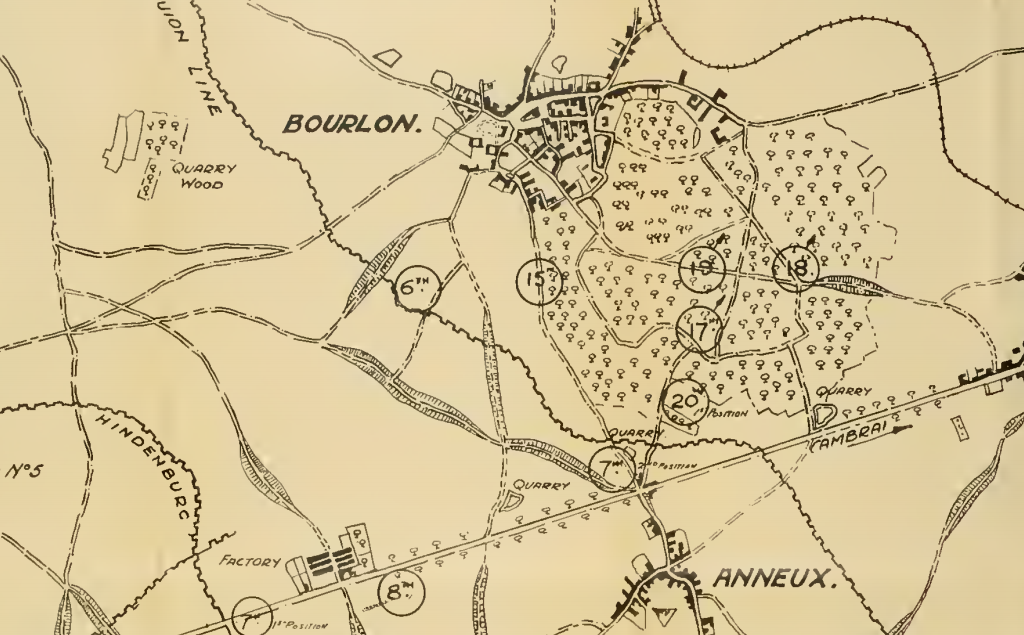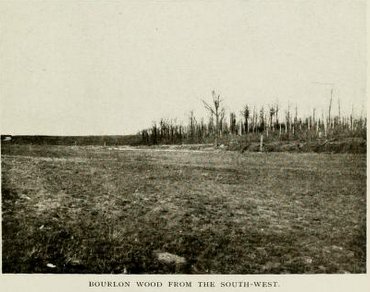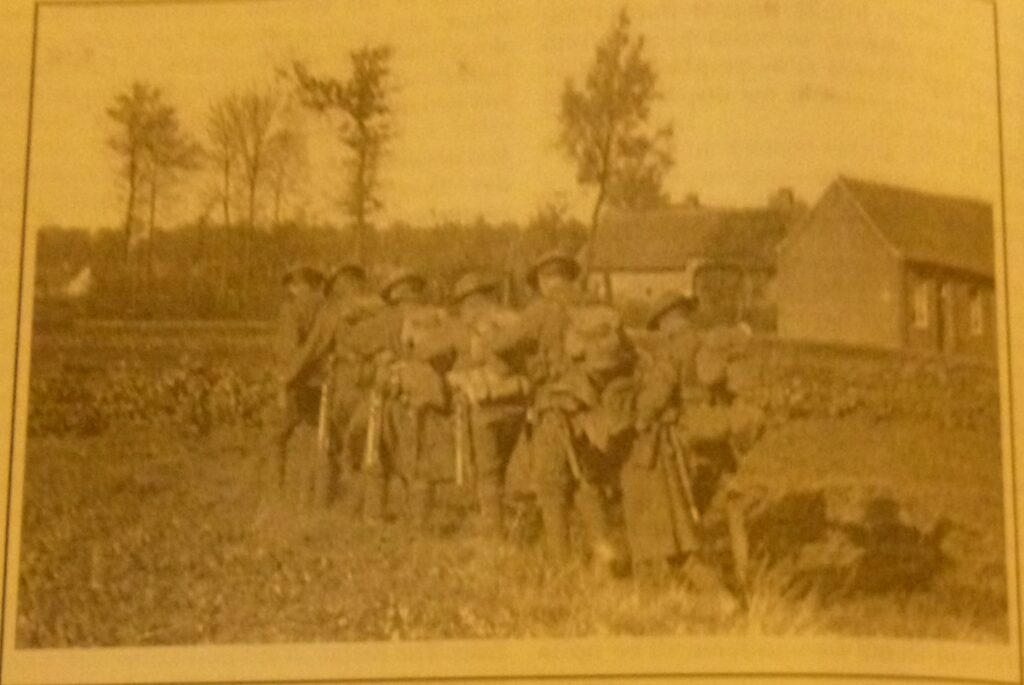On 27th November, the troops of 141st Brigade em-bussed at 8am at Rocquigny and proceeded via Le Transloy and Bapaume for Lebucquiere. The head of the column arrived at 1145am and the troops rested on the roadside awaiting further orders.

Transfer to the Bourlon Wood Line.
The Divisional Commander arrived at Lebucquiere at 12 noon and, by 1215pm, 141st Brigade was instructed to proceed to the Hindenburg Support Line, south west of Graincourt. At 1240pm, the London Irish and 20th Battalions were ordered to proceed by companies at 200 yards interval to the Hindenburg Support Line and be prepared to move in support of 62nd Division. The troops moved forward via Velu–Beaumetz les Cambrai–Doignies to Demicourt but owing to the extraordinary congestion of the roads by artillery and transport, progress was slow. Brigade reported that the Battalion, less Lewis guns, were in position at 6pm. The delay with the Lewis guns were due to the condition of the roads which, apart from heavy traffic and broken bridges over the Canal du Nord, were badly churned up and deep with mud. The transport, however, duly succeeded in reaching their respective units and the guns and the rations were safely delivered.
The following morning, 28th November, the line held by the left and right Brigades of 62nd Division was reconnoitred and at night, 141st Brigade moved forward and relieved 186th Infantry Brigade and two dismounted Battalions of the Cavalry Division. The relief was a difficult operation as the troops were unfamiliar with the locality. Guides were late and the approaches to the line were heavily shelled by the enemy. At 945pm, the relief was complete and the 141st Brigade occupied the front line which ran through the middle of Bourlon Wood.
The firing line was ill defined and where trenches existed they were of a very sketchy description and for the most part the line consisted of a series of posts and rifles pits. The London Irish relieved 3rd Battalion of Dismounted Cavalry in the right section with Headquarters in the Wood at the Chalet. 17th Battalion took over the left section and shared Headquarters with the London Irish. On the left of 17th Battalion, 140th Brigade held the line and on the right of the London Irish, the Guards Division was in position. The 19th Battalion was disposed with four companies in depth in the Wood without trenches in the rear of 17th and 18th Battalions, and 20th Battalion was aligned in breadth about 100 yards from the southern edge of the Wood.
As a result of a personal reconnaissance by GOC 141st Brigade, it was urged that an excessive number of men were being crowded into the Wood and that the locality could be adequately defended by less troops. GOC 62nd Division, however, acting on instructions from IV Corps, insisted on the whole of 141st Brigade being put into the Wood in view of the importance of the position and the expected enemy counter attacks.

Shelling by the Enemy.
The situation on the Wood was thoroughly uncomfortable and all night the enemy bombarded the positions of 141st Brigade without intermission using a considerable amount of gas shell. Very heavy casualties were sustained and the thick undergrowth in the wood held the gas and necessitated the troops wearing their masks for long periods.
At 10am on 29th November, GOC 47th Division took command of the front and at this time seven Battalions (including two battalions of dismounted cavalry), 47 machine guns and one Battalion of 59th Division were in Bourlon Wood.
On assuming command, GOC 47th Division at once made arrangements to reduce the number of troops in Bourlon Wood and, by the morning of 30th November, the garrison was brought down to four battalions and 20 machine guns.
Very little work had been done in the direction of consolidating the line in Bourlon Wood either by entrenching or organising the defences. No cover for supporting troops had been dug and no tools were available.
Heavy shelling, which had continued during the night became intense at 635am on 29th November when the line was bombarded by gas, heavy and light high velocity shells. Hostile aircraft flew low over the Wood observing the effect of the shelling and the disposition of the troops.
An SOS signal was put up on the right and repeated by 18th Battalion HQ at the Chalet and HQ in the Quarry. The signal was at once answered by the artillery and although it appeared that the enemy was endeavouring to launch a heavy attack, the work of the artillery and front line troops with rifle and Lewis guns prevented the assault from developing.
Throughout the day, heavy shelling continued on the whole front, particularly in the Wood. Graincourt village was also very severely shelled. Heavy casualties occurred in the front line and both 18th and 17th Battalions had a bad time. A battalion of dismounted cavalry which had remained in the Wood was relieved by 17th Battalion, and 20th Battalion was withdrawn to Hindenburg Support during the evening.
After a night much disturbed by shelling, the enemy, at 3am on 30th November, opened a fierce bombardment along the whole front from west of Moeuvres to Fontaine-Notre Dame including Graincourt. Enemy infantry concentrations were reported and our artillery opened fire on SOS lines. Brigade warned 20th Battalion (in reserve) to stand by and 19th Battalion was ordered to be prepared to place one or two companies at the disposal of 15th Battalion on the left.
The German Attack.
Germans delivered heavy attacks on the left flank Division (2nd Division) and against 56th Division beyond them. Simultaneously, on the north of Bourlon Wood, 140th Brigade was assailed but the Germans were brought to a standstill by accurate artillery, machine gun and rifle fire. Some ground was lost on the left of the Division and 6th and 15th Battalions were forced back slightly, although the line remained unbroken. As a precautionary measure, at 1040am, IV Corps advised 47th Division to be prepared to move back the artillery in Graincourt valley in case of a heavy attack from the north and teams were ordered to be brought up in readiness.
At 110pm, 20th Battalion (in reserve with 350 men) was ordered to move to a position on the spur 200 yards north east of Anneux village to cover a possible retirement from Bourlon Wood. One Company of 19th Battalion (in support) was moved up to reinforce the London Irish.
At 244pm, a concentration of the enemy was observed along the line of railway north east of Bourlon and the SOS signal was put up on 141st Brigade’s front. Artillery, machine gun and rifle fire effectively broke up the enemy formations. Very heavy casualties were inflicted on the enemy by the Division’s machine guns during the attack of the morning and the tactical grouping of guns was a very material factor in the successful defence of the Division’s front.
During the evening, the enemy’s artillery fire slackened and during lulls every opportunity was taken to reorganise. At 5pm, 20th Battalion was sent forward to reinforce the London Irish, who had suffered heavy losses during the day’s fighting. The Company of 19th Battalion, previously attached to the London Irish, reverted to command of OC 19th Battalion. Later in the evening, two companies of 22nd Battalion moved up to support 17th Battalion, our neighbours on the left, and two companies of 22nd Battalion reinforced 19th Battalion in support. During the day, the enemy enjoyed excellent observation; several of his balloons overlooked Bourlon Wood and German aircraft flying low, swept along the battle zone unchecked. Five enemy planes came to earth in our lines: three crashing and two making forced landings.
The defenders of the Wood endured a gruelling day. They were ceaselessly bombarded by high explosives, which brought trees crashing about their ears, shelled with gas, which saturated the Wood with a loathsome, heavy vapour and clung to the dense undergrowth, filled the hollows and which even a strong wind failed to disperse. Digging to improve the few trenches and pits when wearing respirators was a most difficult task and as exhausted men momentarily removed their masks, either in the hope of easier breathing or to take a drink from their water bottles, they became casualties from the concentration of gas.
Stretcher bearers and aid post staff were hard put to deal with the enormous number of gassed men. The Battalion aid post at the Chalet became crowded with casualties and the difficulty of evacuating the gassed and wounded occasioned great anxiety.
The enemy’s gas caused the men to suffer from hoarseness, acute irritation of the mucous membrane, vomiting and blindness. Only the most severe cases could be treated as lying cases and in view of the rapidity with which blindness ensued, the men were sent down as far as possible as walking cases by the route overland from Bourlon Wood, across open country east of Annuex to the main dressing station at Flesquieres. Scores of men blinded by gas were marshalled in groups and sent off in Indian file, led by a stretcher bearer or lightly wounded man, each man holding on to the tunic of the man preceding him. The landscape between the Wood and Flesquieres was thick with such tragic processions.
At Flesquieres, every vehicle available was pressed into service and utilised to bear away the ever growing streams of gassed and wounded. Medical officers and orderlies in dressing stations were overcome by emanations from the gas soaked clothing of casualties and, to minimise this effect, all gas soaked clothing was, where possible, removed in the open. Many men were stripped to the skin and were sent to the rear draped in blankets.
141st Infantry Brigade received orders from Division at midnight on 30th Nov/1st Dec to continue holding their present positions and the following telegram was received from the Divisional Commander, Major General Sir CF Gorringe KCB CMG DSO:
“I heartily congratulate all ranks of the 140th and 141st Brigades and the RA for their gallant and stubborn resistance this day to all enemy attacks. The enemy has clearly suffered heavily and have failed in their attempts to capture Bourlon Wood, the honour of defending which tactical feature has been entrusted to us. I rely on you to hold the ground we occupy and am confident that, if the enemy renews his attack, he will suffer still greater losses than he has today.”
During the night of 30th November/1st December, the enemy shelling of Bourlon Wood was very heavy just before midnight, mustard gas being freely used but later the fire eased off considerably. Working parties, toiling in very trying circumstances, established dumps of tools, water and stocks at Anneux Chapel: such stores being sufficient for the needs of the whole Brigade. Also, ammunition, rations and tools were taken up to the front line with infinite labour.
During the morning of 1st December, a vigorous artillery duel continued, during which the Wood was again heavily bombarded with gas shell. No infantry attack against the 141st Brigade front occurred but a German fighting patrol, consisting of 20 men, approached our line and was destroyed by fire from Lewis guns and rifles.

Relief for 141st Brigade and the London Irish in Hindenburg Support.
Division confirmed orders for the relief of 141st Brigade and, during the night of 1st/2nd December and early morning, the Brigade withdrew from Bourlon Wood on arrival of 142nd Brigade. The London Irish, in the right section of the front line, was relieved by 22nd London Battalion and moved back, with 17th and 20th Battalions, to Hindenburg Support.
On 2nd December, the area of ground lost by 6th and 15th Battalions was made good by 7th and 8th Battalions in a brilliantly executed night attack in which, besides re-establishing the original line, 52 prisoners and 16 machine guns were taken.
Therefore, on 2nd December, the position was that the Division was in secure possession of the whole of the line taken over from 62nd Division, in spite of the enemy’s incessant infantry and artillery pressure. The stubborn defence of the Wood and the fighting qualities of the Division earned high praise from Sir Douglas Haig, the GOC, who wrote as under:
“Though exposed throughout the day to repeated assaults of superior forces, they beat off all attacks with the heaviest losses to the enemy and by their gallant and steady conduct established very largely to the security of the Division engaged on the whole front of the attack.”
On 2nd December, 141st Brigade in Hindenburg Support spent a quiet day and was principally occupied in reorganising and checking casualties. The reinforcement details from rear Headquarters – under Captain Hobbs – joined the Battalion at night, after an exciting journey by bus and on foot. When passing through Velu, the buses came under fire and four men were killed and several wounded.
After a cold, but quiet night, the Battalion carried out normal routines during the day. Forward, the black mass of Bourlon Wood looming ominously on the skyline and overhung by a pall of dark smoke, was still under severe enemy fire. Graincourt was also shelled savagely – the village being a favourite target for the enemy’s heavy calibre shells.
The Evacuation of Bourlon Wood.
Orders for the evacuation of Bourlon Wood had been received and, in preparation for the retirement to the Hindenburg Support Line, personnel of the RE were busy mining dumps, dug outs and derelict tanks. The troops were in an angry frame of mind at the prospect of withdrawing voluntarily from positions, which had been held in the face of such severe pressure and at the cost of so many lives but were not unmindful of the reasons which justified such a decision.
The difficult operation of evacuating the Wood and country to the south was carried out successfully on the night of 4th/5th December and the Division established a series of strong points on forward spurs and a new front line in Hindenburg Support.
Relief from Hindenburg Support and the Formation of a Composite Battalion.
The London Irish were due to be relieved at 10pm on 4th December and, while waiting for the relief during the night observed that the line was strangely quiet although the enemy was firing red rockets continuously. The 21st Battalion arrived at 3am on 5th December, whereupon the London Irish moved out of Hindenburg Support and proceeded to transport lines via (canal) Lock 7 and along the deep, brick lined and dry bed of the Canal. At transport lines, the men enjoyed hot tea and bacon and then resumed the march to Ruyaulcourt where huts were allotted.
As the result of losses sustained in the Bourlon sector, 17th, 18th and 19th Battalions were very much reduced in strength and were formed into a composite Battalion of four companies under Colonel Hughes of 17th Battalion, the Battalion comprised two companies of 17th Battalion and one company each of 18th and 19th Battalions. The London Irish Company was put under Major Beresford of 17th Battalion.